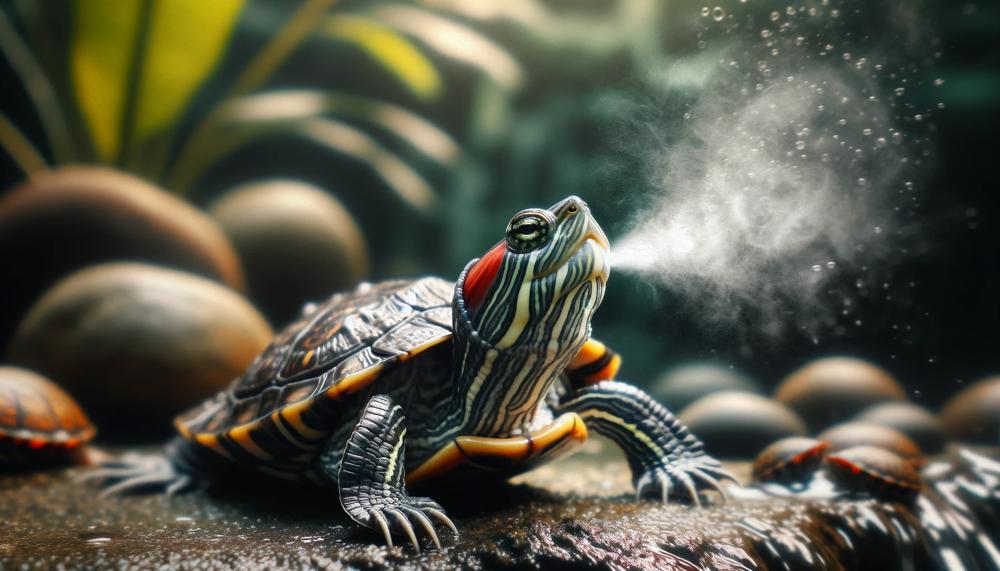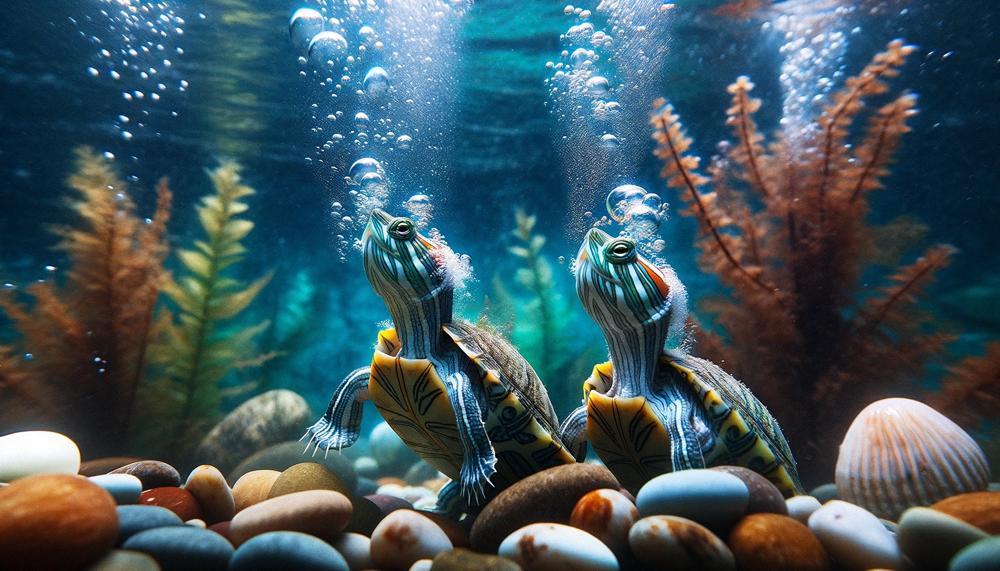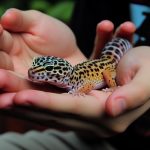Dive into the watery world of the red-eared slider, a creature whose lifestyle straddles the boundary between land and water. In this in-depth exploration, we’ll submerge into the fascinating abilities of these turtles, particularly their method of breathing while submerged.
It’s a journey that promises to shatter common misconceptions, unveil scientific wonders, and redefine what we know about aquatic life.
In this article, we’ll uncover:
- The surprising truth about how red-eared sliders manage their oxygen needs underwater.
- The unique physiological adaptations that enable these turtles to stay submerged for extended periods.
- The implications of their underwater breathing for their behavior, habitat, and survival strategies.
Join us as we delve into the depths, where the lines between air and water blur, and discover how the red-eared slider thrives in its amphibious world. This piece isn’t just an exploration; it’s an invitation to look beneath the surface and appreciate the complex ballet of nature’s design.
Contents
- 1 How Long Can Red Eared Slider Turtles Hold Their Breath?
- 2 Red Eared Slider Turtles Hold Breath For 30-35 Minutes
- 3 Underwater Time: 5-7 Minutes For Red Eared Slider Turtles
- 4 Brumation: Winter Resting Period For Slider Turtles
- 5 Rare Cases Of Drowning In Red Eared Slider Turtles
- 6 Breath-Holding Abilities In Comparison: Sea Turtles Vs. Sulcata Tortoise
- 7 Semi-Aquatic Life: Red Eared Sliders Need Air Too
- 8 Average Breath-Holding Time: 30 Minutes For Red Eared Slider Turtles
- 9 Needing Air During Activity: 10 Minutes For Slider Turtles
- 10 Sleep Patterns: Red Eared Sliders Can Stay Underwater For 2-3 Hours
- 11 Exceptional Circumstances: Red Eared Sliders Holding Breath For Months
- 12 Conclusion
How Long Can Red Eared Slider Turtles Hold Their Breath?
Red-eared slider turtles, remarkable for their resilience and adaptability, boast an impressive ability to hold their breath underwater. These aquatic creatures, adept at navigating their underwater domain, can submerge themselves for substantial durations, a testament to their specialized adaptations and survival strategies.
Breath-Holding Capacity of Red-Eared Slider Turtles
| Duration | Condition | Notes |
| 20-30 minutes | Average underwater swimming | Common for active swimming or foraging. |
| Up to 2 hours | Submerged without stress | Seen in calm, resting states or in cooler water temperatures. |
| Up to 3 hours | Maximum breath-holding | Extreme cases, under ideal conditions, possibly when in danger or hibernating. |
These turtles have mastered the art of oxygen conservation, significantly slowing down their heart rate to reduce oxygen consumption while underwater. This remarkable adaptation, along with the ability to extract oxygen directly from the water through their cloaca, enables them to stay submerged for extended periods.
It’s worth noting, though, that despite their impressive abilities, there’s a limit to how long these turtles can stay underwater without surfacing for air. Exceeding this limit poses a risk of drowning, highlighting the importance of monitoring their environment to ensure their safety and well-being.
Red Eared Slider Turtles Hold Breath For 30-35 Minutes
Red Eared Slider Turtles astound with their ability to linger beneath the water’s surface, holding their breath for a considerable duration of 30 to 35 minutes under normal circumstances.
This remarkable feat stems from a symphony of physiological adaptations, crafted by nature to suit their aquatic lifestyle.
Adaptations for Underwater Breath-Holding:
- Slow Metabolism: In tranquil states, such as sleep or minimal activity, these turtles can drastically lower their metabolic rate. This slowdown reduces oxygen demand, enabling them to conserve the air in their lungs for extended periods.
- Cloacal Respiration: Perhaps their most peculiar adaptation is the use of their cloaca, an all-purpose opening, for respiration. The cloaca and its associated bursae have a rich supply of blood vessels, allowing for the exchange of gases directly with the surrounding water. This is especially crucial during the colder months of hibernation.
- Behavioural Strategies: Red Eared Sliders are adept at managing their oxygen levels through behavioural means. By remaining still and reducing their activity, they minimize oxygen consumption, extending their underwater sojourns.
Table of Key Adaptations:
| Adaptation | Function | Benefit |
| Slow Metabolism | Reduces oxygen demand | Longer breath-hold |
| Cloacal Respiration | Gas exchange with water | Survival during hibernation |
| Behavioural Strategies | Minimize movement and oxygen use | Extend underwater duration |
Their innate capabilities for extended underwater habitation highlight the Red Eared Slider Turtle’s incredible adaptation to their aquatic environment.
It’s a testament to the marvels of evolution, equipping these creatures to thrive in their habitats, from the calm waters where they slumber to the depths they explore.
Underwater Time: 5-7 Minutes For Red Eared Slider Turtles
Red Eared Slider Turtles can remain submerged for varying lengths of time, primarily dependent on activity level and water temperature. On average, these turtles can hold their breath for about 5-7 minutes during active swimming.
However, when resting or hibernating, they can stay underwater for extended periods – up to several months under the right conditions, thanks to their unique physiological adaptations.
| Condition | Underwater Time | Explanation |
| Active Swimming | 5-7 Minutes | During vigorous activities or swimming. |
| Resting | Hours | While in a state of minimal activity or sleep. |
| Hibernating | Up to Several Months | In cold water during winter, utilizing cloacal respiration. |
Red Eared Sliders are adept at adjusting their underwater duration based on their immediate needs and environmental conditions.
Their ability to engage in cloacal respiration – absorbing oxygen directly from the water through their cloaca – is a remarkable adaptation for longer underwater endurance, especially during colder months when their metabolism slows down.
Brumation: Winter Resting Period For Slider Turtles
Brumation is a period of dormancy for reptiles akin to hibernation in mammals, tailored for cold-blooded creatures to weather the chilly winter months. For red-eared slider turtles, this entails a significant slow-down in their bodily functions to conserve energy, given the sparse food availability.
As the mercury dips, these shelled survivors adjust their life’s tempo, dialing down their heart rate and respiration, and entering a state of low activity.
During brumation, the breathing of red-eared slider turtles undergoes a fascinating transformation. Traditional lung-breathing takes a backseat, as these turtles predominantly rely on cloacal respiration—a process where oxygen is absorbed through blood vessels in the cloaca, an internal pouch serving multiple functions.
This adaptation is a marvel of nature, enabling sliders to remain submerged for extended periods, avoiding the need to surface for air in frigid conditions.
Table 1: Brumation Impact on Red-Eared Slider Turtles
| Aspect | Normal Condition | During Brumation |
| Heart Rate | Normal | Significantly Slowed |
| Breathing | Lung Respiration | Cloacal Respiration |
| Activity Level | Active | Low |
| Food Intake | Regular | Minimal |
This clever survival strategy ensures that red-eared sliders can thrive through the winter, ready to emerge with the warmth of spring.
Rare Cases Of Drowning In Red Eared Slider Turtles
Rare cases of drowning in Red Eared Slider Turtles often stem from preventable situations. Here’s a closer look at the causes and prevention strategies:
| Cause | Explanation | Prevention |
| Trapping | Turtles can become trapped under water by decorations or in spaces too tight to escape. | Ensure the tank setup allows free movement and avoid tight spaces where turtles could get stuck. |
| Weakness | Illness or injury can weaken a turtle, making it hard to swim to the surface. | Regularly monitor health, and provide prompt care for any sickness or injuries. |
| Improper Water Levels | Too deep water can challenge younger or weaker turtles to reach the surface for air. | Adjust water levels according to the size and strength of your turtle, ensuring easy access to air. |
| Poor Water Quality and Temperature | Unsuitable water conditions can stress turtles, leading to exhaustion or health issues. | Maintain clean, appropriately heated water to promote health and reduce stress. |
| Lack of Proper Basking Area | Turtles need to bask to regulate their body temperature and to rest. | Provide a basking platform that is easily accessible from the water. |
By understanding these causes, owners can take proactive steps to safeguard their Red Eared Sliders from such rare but perilous incidents.
Breath-Holding Abilities In Comparison: Sea Turtles Vs. Sulcata Tortoise
Adaptations and Abilities
Sea turtles and sulcata tortoises inhabit vastly different environments, leading to distinct adaptations in their breath-holding capabilities. Sea turtles, aquatic by nature, exhibit remarkable breath-holding abilities, whereas sulcata tortoises, being terrestrial, have more limited capabilities in this regard.
| Characteristic | Sea Turtle | Sulcata Tortoise |
| Lung Structure | Large lungs with air pockets | Smaller, less specialized lungs |
| Metabolic Rate | Slow, aiding in longer breath-holding | Faster than sea turtles |
| Oxygen Storage | Can store oxygen in muscles | Limited capacity for oxygen storage |
| Breathing Adaptation | Can extract oxygen from water through lungs | Does not possess this ability |
| Breath-Holding Duration | Up to 4 hours, varying with species and environment | Significantly less, suited for terrestrial life |
Implications for Each Species
Sea turtles’ adaptations, like large lungs and the ability to store oxygen in their muscles, enable them to dive and feed underwater for extended periods. This ability is crucial for their survival in aquatic environments.
Conversely, sulcata tortoises, adapted for a terrestrial lifestyle, lack these specialized features and thus have a much shorter breath-holding capacity. Their respiratory system is tailored for a different set of challenges on land.
Key Factors Influencing Breath-Holding
For sea turtles, the duration they can hold their breath is influenced by species, water temperature, and age. The colder the water, typically the longer they can hold their breath due to a slower metabolism.
In contrast, sulcata tortoises’ breath-holding ability is generally consistent, aligning with their need for regular breathing in terrestrial environments.
Semi-Aquatic Life: Red Eared Sliders Need Air Too
Red Eared Sliders, as the charming semi-aquatic beings they are, have a rather clever system for breathing, not just above water but beneath it too. On land, they rely on their lungs, just like us humans, taking in air through their nostrils and into their lung chambers where the oxygen gets picked up by the blood. Simple, right?
But here’s where it gets intriguing: underwater, they switch to a sort of secret mode.
These turtles can absorb oxygen directly from the water. They do this through a process involving their cloacal cavity, a part of their body that can take in water and extract oxygen from it. This is a bit like having a built-in snorkel, except it works while they’re completely submerged.
It’s a nifty adaptation that allows them to stay underwater for lengthy periods, especially during their hibernation phase in colder months, without coming up for air.
The Red Eared Slider’s dual breathing capabilities are essential for their survival, giving them the flexibility to thrive both in aquatic environments and on terra firma.
For pet owners, this means ensuring their habitat has both water deep enough for swimming and a dry area for basking, reflecting their natural environment where they can manage their body temperature and metabolism efficiently.
Let’s break down their breathing mechanisms in a clearer way:
| Environment | Breathing Method | Adaptation |
| Land | Lungs | Similar to terrestrial animals, using nostrils to inhale air. |
| Water | Cloacal Respiration | Specialised tissue in the cloacal cavity absorbs oxygen directly from water. |
This brilliant adaptation ensures Red Eared Sliders can enjoy the best of both worlds, but it also underlines the importance of a well-maintained habitat for these semi-aquatic reptiles, particularly for those in captivity.
Average Breath-Holding Time: 30 Minutes For Red Eared Slider Turtles
Red eared slider turtles, those resilient and adaptable critters, have quite the knack for holding their breath underwater.
On average, they can keep it up for about half an hour. Let’s break down the specifics of their impressive underwater endurance and what makes them such fascinating creatures.
Breath-Holding Abilities
| Normal Conditions | About 30 minutes | Day-to-day, in their aquatic escapades. |
| Hibernation | Months | During the cooler months, they can hibernate underwater without surfacing for air. |
| Oxygen Absorption | Through skin and cloacal cavity | They have the ability to absorb oxygen directly from the water, a handy adaptation for life submerged. |
Why 30 Minutes?
Red eared sliders are semi-aquatic marvels. Their lives are a delicate dance between the need to soak in the sun on a cosy log and the instinct to dive beneath the surface, exploring or escaping threats. This 30-minute breath-holding capability is more than a mere party trick; it’s essential for their survival.
Whether it’s avoiding predators or simply taking a leisurely swim, this ability keeps them safe and sound.
A Basking We Will Go
Despite their love for the water, these sliders are sun worshippers at heart. Basking is crucial; it’s their way of charging up, metabolizing properly, and staying healthy.
So, even though they could stay submerged for up to 30 minutes, they’ll often pop up sooner, especially in a tank setting, to catch some rays.
The Need for Land and Water
It’s all about balance for red eared sliders. A setup that mimics their natural habitat needs to offer both aquatic and terrestrial options. Too much time in the water? Not great. Too much time on land? Also not ideal. They’re creatures of habit and environment, and getting this mix right is key to their well-being.
Signs of Trouble
Staying underwater too long or refusing to bask can signal something’s amiss. Whether it’s stress, an unsuitable environment, or health issues, these are signs worth paying attention to. After all, a happy slider is a healthy slider.
Needing Air During Activity: 10 Minutes For Slider Turtles
Slider turtles, known for their lively underwater escapades, necessitate periodic breaks to the surface for air. The span they can remain submerged varies with activity levels.
When actively exploring or feeding, they typically resurface every 10 minutes to breathe. Here’s a closer look at their underwater breath-holding capabilities:
| State | Duration Underwater | Notes |
| Active | Approximately 10 minutes | During exploration or feeding |
| Resting | Up to 30 minutes | In calm, undisturbed states |
| In captivity | Every 30 minutes | Regular surfacing observed |
Red eared sliders, adept in both aquatic and terrestrial environments, have evolved to optimize their oxygen intake. This duality ensures they thrive, balancing their time between basking in sunlight and diving deep.
Their capacity to absorb oxygen through skin submerged in water complements their need for atmospheric air, reflecting an intricate balance essential for their metabolic processes.
Sleep Patterns: Red Eared Sliders Can Stay Underwater For 2-3 Hours
Red eared sliders, those vividly marked denizens of waterways, have intrigued us with their ability to linger underwater for hours, seemingly defying the urgent need for air that governs most creatures. Let’s dive into how these resilient reptiles manage this aquatic feat.
At the heart of their ability to stay submerged for 2-3 hours lies a fascinating adaptation related to their respiratory system and their overall cold-blooded (ectothermic) metabolism. Unlike us, these turtles can drastically slow down their metabolism, which in turn reduces their oxygen needs. This biological wizardry allows them to make the most of the oxygen they’ve stored before diving deep.
But that’s not all. During their underwater escapades, red eared sliders can engage in what’s akin to “cloacal respiration.” This remarkable process involves the cloaca (a multipurpose opening) absorbing dissolved oxygen directly from the water. It’s a nifty trick, especially during the colder months or when taking a prolonged nap underwater.
Here’s a table breaking down the key points of their underwater survival:
| Feature | Function | Benefit |
| Slow Metabolism | Decreases oxygen demand | Longer underwater stays |
| Cloacal Respiration | Absorbs oxygen from water | Enables breathing without surfacing |
| Cold-Blooded Metabolism | Adjusts body temperature to environment | Reduces energy and oxygen use |
To sum up, red eared sliders have evolved a unique set of adaptations that allow them to thrive underwater. Whether they’re actively exploring or catching some Z’s submerged, these turtles exemplify nature’s ingenuity.
Just imagine, while we’re up here taking breath after breath, these shelled marvels are down there, masters of their aquatic domain, making the most of every gulp of air they took hours ago.
Exceptional Circumstances: Red Eared Sliders Holding Breath For Months
Red Eared Sliders, fascinating creatures that they are, boast an impressive feat of being able to hold their breath for extensive durations. This unique capability isn’t just for show; it’s a survival strategy honed over millennia.
Their breath-holding prowess is particularly pronounced under specific conditions, which are outlined below:
| Condition | Description | Duration |
| Normal Activity | While engaging in everyday activities within their aquatic environment. | 30-35 minutes |
| Brumation | During the winter, they enter a dormant state, significantly reducing their metabolic needs and oxygen requirements. | 3-4 months |
| Sleeping | When resting or sleeping underwater, their need for oxygen decreases. | 2-3 hours |
| Extreme Environmental Conditions | In response to scarce oxygen availability or polluted waters, they can adjust by minimising their movement and metabolic rate. | Varies |
| Unique Physiological Circumstances | During periods of stress or when adapting to sudden changes in their environment. | Depends on situation |
The red-eared slider’s ability to hold its breath for such lengths of time is rooted in both physical adaptations and behavioural strategies. Their cloacal respiration system is a marvel, allowing them to extract oxygen directly from the water, which is critical during the brumation period or in poorly oxygenated environments.

It’s essential for owners and enthusiasts to understand these conditions to ensure the health and wellbeing of their turtles.
Providing a habitat that mimics their natural environment as closely as possible will support their unique physiological needs, including access to clean water and areas where they can surface for air.
Conclusion
Among the wonders of nature, red-eared slider turtles are exceptional because they are adept at adapting to aquatic environments and have a remarkable ability to move between the water and the air. Their capacity for extended submersion—from a few minutes during vigorous swimming to many months in the peace and quiet of brumation—underlines an amazing evolutionary path.
With their distinct physiological features, such cloacal respiration and a regulated metabolism to save oxygen, these turtles represent the epitome of adaptability and survival.
This remarkable capacity to hold one’s breath is not without limitations, however. It is a striking reminder of the delicate equilibrium necessary for their aquatic environments and the attention to detail required while keeping them in captivity. For their health and wellbeing, it is essential that their surroundings resemble the natural world, complete with enough room for swimming, sunbathing areas, and water of the highest quality.
Beyond being a narrative of survival, the red-eared slider’s journey invites viewers to wonder at the beautiful dance of nature’s creation, in which each organism plays a part in the complicated web of life and every adaption has a purpose.






